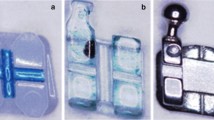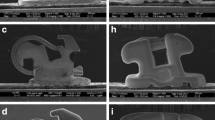Abstract
Objectives
To evaluate force loss due to friction (FR) with an emphasis on esthetic brackets and their design differences during simulated canine retraction.
Materials and methods
The tested brackets were round and sharp-cornered conventional-ligating brackets and round-cornered self-ligating brackets. The tested archwires were stainless steel (0.018 × 0.025″ and 0.019 × 0.025″, and 0.018″) archwires. A total of 90 bracket–archwire combinations in 9 equally-sized groups (n = 10) were analyzed. Canine retraction was experimentally simulated in a biomechanical set-up utilizing the custom-made orthodontic measurement and simulation system (OMSS) using a NiTi coil spring that delivered a constant force of 1 N. The simulated retraction path was up to 4 mm. FR was compared among groups using the Welch t‑test. Significance level (α) was set to 0.05.
Results
The round-cornered conventional-ligating bracket exhibited the least FR (28.6 ± 5.4%), while there were no significant differences in FR between the round-cornered conventional-ligating bracket and the round-cornered self-ligating bracket with 0.018″ stainless steel wires. However, the round-cornered self-ligating bracket exhibited the least FR (34.9 ± 5.1% and 39.3 ± 4.6%) with 0.018 × 0.025″ and 0.019 × 0.025″ stainless steel archwires, respectively. The sharp-cornered conventional-ligating bracket showed the highest FR of 72.4 ± 3.0% among the bracket systems tested in this study.
Conclusions
The round-cornered conventional-ligating bracket showed less FR when compared to sharp-cornered conventional-ligating bracket. Conversely, the round-cornered conventional-ligating bracket exhibited greater FR when compared to the round-cornered self-ligating bracket, with an exception with respect to the 0.018″ wire. In general, FR increased with increased wire dimension.
Zusammenfassung
Ziele
Bewertung des Kraftverlusts aufgrund von Reibung (FR) mit Schwerpunkt auf ästhetischen Brackets und deren Designunterschieden während einer simulierten Eckzahnretraktion.
Materialien und Methoden
Bei den untersuchten Brackets handelte es sich um runde und scharfkantige konventionell-ligierende Brackets sowie um runde selbstligierende Brackets, bei den untersuchten Bögen um Bögen aus Edelstahl (0,018 × 0.025″ und 0,019 × 0.025″ und 0,018″). Insgesamt wurden 90 Bracket-Bogendraht-Kombinationen in 9 gleich großen Gruppen (n = 10) überprüft. Die Eckzahnretraktion wurde experimentell in einem biomechanischen Aufbau unter Verwendung des speziell angefertigten kieferorthopädischen Mess- und Simulationssystems (OMSS) mit einer NiTi-Schraubenfeder simuliert, die eine konstante Kraft von 1 N ausübte. Der simulierte Retraktionsweg betrug bis zu 4 mm. Die FR wurde zwischen den Gruppen mit dem Welch-t-Test verglichen. Das Signifikanzniveau (α) wurde auf 0,05 festgelegt.
Ergebnisse
Das abgerundete konventionell-ligierende Bracket wies die geringste FR auf (28,6 ± 5,4%), während es keine signifikanten Unterschiede in der FR zwischen dem abgerundeten konventionell-ligierenden Bracket und dem abgerundeten selbstligierenden Bracket mit 0,018″ Edelstahldrähten gab. Das abgerundete selbstligierende Bracket wies jedoch die geringste FR (34,9 ± 5,1% und 39,3 ± 4,6%) mit 0,018 × 0,025″ bzw. 0,019 × 0,025″ Edelstahldrähten auf. Das scharfkantige konventionell-ligierende Bracket wies unter den in dieser Studie getesteten Bracketsystemen mit 72.4 ± 3,0% die höchste FR auf.
Schlussfolgerungen
Das abgerundete konventionell-ligierende Bracket wies im Vergleich zum scharfkantigen konventionell-ligierenden Bracket eine geringere FR auf. Umgekehrt wies das abgerundete konventionell-ligierende Bracket im Vergleich zum abgerundeten selbstligierenden Bracket einen höheren FR auf, mit Ausnahme des 0,018″-Drahtes. Generell nahm die FR mit zunehmender Drahtgröße zu.






Similar content being viewed by others
References
Kusy R (1999) Influence of archwire and bracket dimensions on sliding mechanics: derivations and determinations of the critical contact angles for binding. Eur J Orthod 21:199–208
Kusy RP (2000) Ongoing innovations in biomechanics and materials for the new millennium. Angle Orthod 70:366–376
Kusy RP, Whitley JQ (1997) Friction between different wire-bracketconfigurations and materials. Semin Orthod 3:166–177
Montasser MA, El-Bialy T, Keilig L et al (2014) Force loss in archwire-guided tooth movement of conventional and self-ligating brackets. Eur J Orthod 36:31–38
Articolo LC, Kusy RP (1999) Influence of angulation on the resistance to sliding in fixed appliances. Am J Orthod Dentofacial Orthop 115:39–51
Bourauel C, Drescher D, Thier M (1992) An experimental apparatus for the simulation of three-dimensional movements in orthodontics. J Biomed Eng 14:371–378
Phukaoluan A, Khantachawana A, Kaewtatip P et al (2017) Comparison of friction forces between stainless orthodontic steel brackets and TiNi wires in wet and dry conditions. Int Orthod 15:13–24
Bednar JR, Gruendeman GW, Sandrik JL (1991) A comparative study of frictional forces between orthodontic brackets and arch wires. Am J Orthod Dentofacial Orthop 100:513–522
Cacciafesta V, Sfondrini MF, Ricciardi A et al (2003) Evaluation of friction of stainless steel and esthetic self-ligating brackets in various bracket-archwire combinations. Am J Orthod Dentofacial Orthop 124(4):395–402. https://doi.org/10.1016/s0889-5406(03)00504-3
Yamaguchi K, Nanda RS, Morimoto N et al (1996) A study of force application, amount of retarding force, and bracket width in sliding mechanics. Am J Orthod Dentofac Orthop 109:50–56
El-Bialy T, Alobeid A, Dirk C et al (2019) Comparison of force loss due to friction of different wire sizes and materials in conventional and new self-ligating orthodontic brackets during simulated canine retraction. J Orofac Orthop 80:68–78
Griffiths HS, Sherriff M, Ireland AJ (2005) Resistance to sliding with 3 types of elastomeric modules. Am J Orthod Dentofac Orthop 127:670–675
Khambay B (2004) Evaluation of methods of archwire ligation on frictional resistance. Eur J Orthod 26:327–332
Kim T‑K, Kim K‑D, Baek S‑H (2008) Comparison of frictional forces during the initial leveling stage in various combinations of self-ligating brackets and archwires with a custom-designed typodont system. Am J Orthod Dentofacial Orthop 133:187.e115–187.e124
Henao SP, Kusy RP (2005) Frictional evaluations of dental typodont models using four self-ligating designs and a conventional design. Angle Orthod 75:75–85
Drescher D, Bourauel C, Schumacher HA (1990) The loss of force by friction in arch-guided tooth movement. Fortschr Kieferorthop 51:99–105
Drescher D, Bourauel C, Thier M (1991) Application of the orthodontic measurement and simulation system (OMSS) in orthodontics. Eur J Orthod 13(3):169–178. https://doi.org/10.1093/ejo/13.3.169
Henriques JFC, Higa RH, Semenara NT et al (2017) Evaluation of deflection forces of orthodontic wires with different ligation types. Braz Oral Res 31:e49. https://doi.org/10.1590/1807-3107BOR-2017.vol31.0049
Loftus BP, Ârtun J, Nicholls JI et al (1999) Evaluation of friction during sliding tooth movement in various bracket-arch wire combinations. Am J Orthod Dentofacial Orthop 116:336–345
Berger JL (1990) The influence of the SPEED bracket’s self-ligating design on force levels in tooth movement: a comparative in vitro study. Am J Orthod Dentofacial Orthop 97(3):219–228. https://doi.org/10.1016/S0889-5406(05)80055-1
Burrow SJ (2009) Friction and resistance to sliding in orthodontics: a critical review. Am J Orthod Dentofacial Orthop 135(4):442–447. https://doi.org/10.1016/j.ajodo.2008.09.023
Kusy RP, Whitley JQ (1990) Effects of surface roughness on the coefficients of friction in model orthodontic systems. J Biomech 23(9):913–925. https://doi.org/10.1016/0021-9290(90)90356-8
Braun S, Bluestein M, Moore BK et al (1999) Friction in perspective. Am J Orthod Dentofacial Orthop 115(6):619–627. https://doi.org/10.1016/s0889-5406(99)70286-6
Husmann P, Bourauel C, Wessinger M et al (2002) The frictional behavior of coated guiding archwires. J Orofac Orthop 63:199–211
Schumacher HA, Bourauel C, Drescher D (1999) The influence of bracket design on frictional losses in the bracket/arch wire system. J Orofac Orthop 60(5):335–347. https://doi.org/10.1007/BF01301246. English, German
Halazonetis DJ (2007) Friction might increase anchorage loading. Am J Orthod Dentofacial Orthop 131:699–700
Author information
Authors and Affiliations
Corresponding author
Ethics declarations
Conflict of interest
A. Youssef, T. El-Bialy and C. Bourauel declare that they have no competing interests.
Additional information
Publisher’s Note
Springer Nature remains neutral with regard to jurisdictional claims in published maps and institutional affiliations.
Rights and permissions
About this article
Cite this article
Youssef, A., El-Bialy, T. & Bourauel, C. Comparative assessment of frictional forces between differently designed esthetic brackets during simulated canine retraction. J Orofac Orthop 84 (Suppl 3), 222–230 (2023). https://doi.org/10.1007/s00056-022-00433-3
Received:
Accepted:
Published:
Issue Date:
DOI: https://doi.org/10.1007/s00056-022-00433-3




